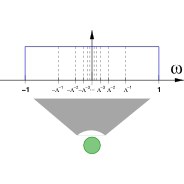Renormalization-Group Methods
Numerical Renormalization Group (NRG)
The Numerical Renormalization Group method is a non-perturbative numerical method which allows the calculation thermodynamic, dynamic and transport properties of quantum impurity systems on all relevant energy and temperature scales. Quantum impurity systems consist of small quantum mechanical systems with local many-body interactions embedded in a host system ("the bath") which is macroscopically large but non-interacting. Examples are Kondo atoms on surfaces and in bulk or quantum dots and molecules attached to conducting leads.
The quantum impurity system is first discretized logarithmically in energy (see figure) and transformed to a one-dimensional linear chain form, and the linear chain form of the model is then iteratively diagonalized to extract the many-body eigenstates and eigenvalues. The method is currently being extended in several directions. These include the calculation of the time-dependence of local observables following a quantum quench, the extension to steady-state thermoelectric transport and the extension to more realistic multi-level and multi-channel quantum impurity models.
R. Bulla, T. A. Costi and T. Pruschke , Rev. Mod. Phys. 80, 395 (2008)
(T. Costi, H. Nghiem, L. Merker)

Real-Time Renormalization-Group (RTRG) - Non-Equilbrium Charge Fluctuations
Charge transport through a quantum dot is basically described by the non-equilibrium Anderson model. Quite generally, the transport can be calculated when the self-energy for the time-evolution – determining the stationary state - and the self-energy for the current are given. The perturbation theory in the tunneling coupling (equivalent to the Nakajima-Zwanzig approach) can be re-organized in two steps: (1) using the wide-band limit, one can integrate out simple Markovian dynamics (2) the remaining, non-trivial self-energy part can be obtained exactly from an infinite hierarchy of real-time renormalization-group equations. The minimal, approximate RT-RG approach that exactly includes the non-interacting limit must at least include self-energy and vertex corrections (hierarchy truncated at 2-loop order). This roughly accounts for renormalized single-electron and cotunneling processes, including leading frequency dependencies. This approach can be implemented due to the advantages offered by recently developed “causal” superfermion techniques. This makes well-defined transport calculations of strongly interacting, non-linear transport at zero temperature possible when excluding the Kondo regime.
R. Saptsov and M. R. Wegewijs, Phys. Rev. B 86, 235432 (2012)
(R. Saptsov, M. R. Wegewijs)

